Background
Trent Richardson came out of Alabama following the much heralded career of Mark Ingram, whom the New Orleans Saints had traded up with New England to draft the prior year in the late 1st Round. Richardson came out after a monster Junior season in which he ran for 1,679 yards and a robust 21 TD on the ground while chipping in 29 catches. He was selected with the 3rd pick overall and despite struggling with a rib injury, put up a good rookie year rushing for 950 yards, 11 TD, and catching 51 passes.
His rookie year would have been highlighted in most circles, however, Washington’s Alfred Morris exploded onto the scene as did Tampa Bay’s Doug Martin and both immediately supplanted Richardson statistically and even nationally.
A dismal 5-11 record saw head coach Pat Shurmur, along with GM Tom Heckert, both sent packing and led to a front office overhaul that featured the introduction of new GM Mike Lombardi along with a new HC in Rob Chudzinski and OC Norv Turner. Chudzinski was best known for his development of tight ends at both The University of Miami also known as THE U and with Antonio Gates of the San Diego Chargers. Norv Turner was known as an especially prolific playcaller and great offensive mind but struggled to get over the hump in the playoffs with the San Diego Chargers and was fired after 6 seasons with an overall 56-40 record.
Norv Turner, and by extension Rob Chudzinski, both run a more modified version of Don Coryell’s “Air Coryell” system, relying heavily on runs out of the shotgun along with deep pass patterns off play action that routinely generate huge yards per catch when they connect.
Here is where Trent Richardson was supposed to come in. Richardson came from Alabama as the ‘next’ great running back in what may go down eventually as a very deep running back class in the next several years. You had a running back who was tailor made to run the ball 25-30 times a game, catch the ball 3-5 times a game, and dominate like he could be another Adrian Peterson. Instead, through just two games, he had run for just 105 yards with a long of 10 yards and had 7 catches.
What went wrong? What happened to the man-beast who collided with a Philadelphia Eagles defender so hard in 2012 that the guy’s helmet popped off and made the highlight reels ad nauseum?
Several flaws came to light, not only related to Trent Richardson’s running style but also the way he schematically fit in Rob Chudzinski’s offense and which partly necessitated the blockbuster trade that was revealed nation wide on Wednesday afternoon.
Let us take a look at some of his plays against the Miami Dolphins in Week 1 and Baltimore Ravens in Week 2.
Run 1: Pitch Left for a 9 Yard Gain
The situation is a 1st & 10 at their own 20 yard line to kick off the game. The TE motions left and at the snap of the ball, the LT and LG pull hard to arc block up ahead of Richardson in what should be an open lane for a big run.

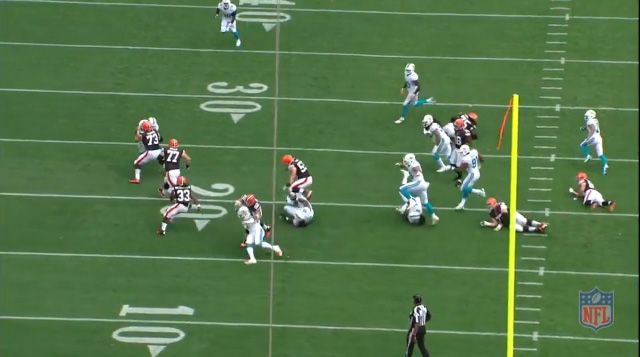
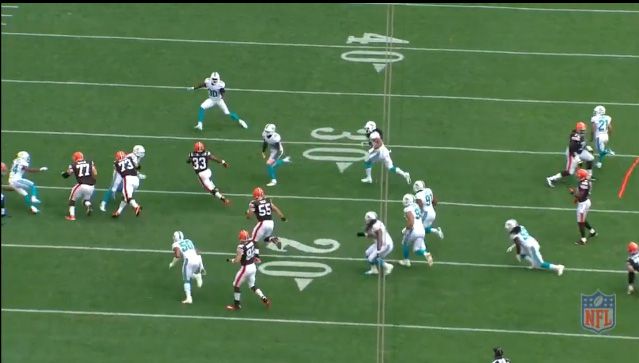
Richardson gets outstanding blocking from Joe Thomas (73) and John Greco (77) on this play. He sets up both of his blockers really nicely, lets the edge get sealed, and bursts up into where the running lane should be. The big difference here is that Richardson lacks the burst to beat the angles of the two deep converging defenders and gets hit by 3 defenders around the 27 yard line.
Those are signs of a good NFL running back who can get north/south and go downhill but may not be effective enough speed wise to outrun defenders and turn a 9 yard run into a 12-14 yard run instead.
Run 2: Dive Right on 2nd & 1 for 5 Yard Gain
This is the very second play of the game and again, it highlights Richardson’s ability to get north in a hurry as well as his vision when surrounded by bodies but also negatively showcases his inability to translate his vision to the burst necessary to turn this into a huge run.
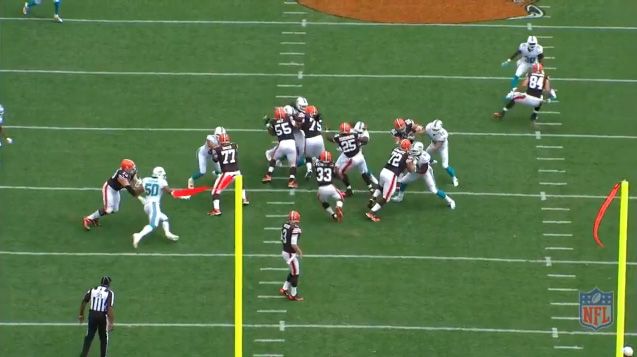
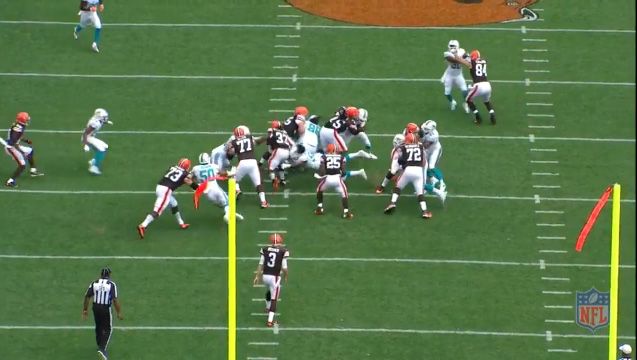
In the first image, Richardson correctly reads the blocking and spots the cutback lane to his left in between LG John Greco (77) and C Alex Mack (55). Take note of the fact that he has planted his foot and started hard towards the hole as well. Now you expect a good RB to burst through the hole, or maybe break any tackle because there is pretty clear daylight ahead of him.
FB Chris Ogbonnaya gets stood up and Richardson ends up getting taken down by a superb diving effort by the defender. What is not seen is Richardson’s very slight delay as he stops/starts to explode through the open hole. It isn’t very much and most fans probably would not pick up on it but what it allowed was the defender to get off Ogbannaya to make a diving tackle attempt as opposed to being out of the play with Richardson off to the races for a probable 20+ yard run.
Catch 1: Check Down on 2nd & 12 for an 18 Yard Gain
Cleveland motions into a Weak I Formation with the ball at their own 37 yard line. Weeden does a good job dumping it off to Richardson who corrals the ball and heads north with a full head of steam. He shows off solid hands but yet again, his lack of a burst really hampers the ability for the play to be any bigger than it turned out.
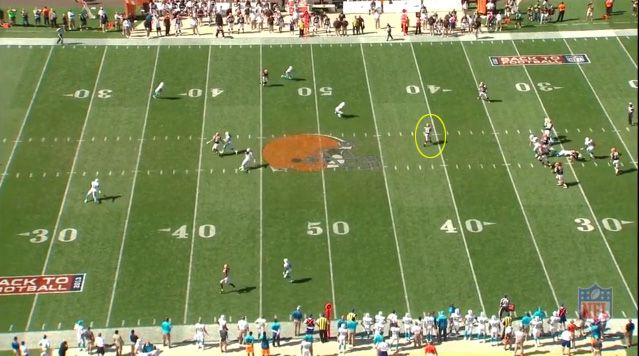
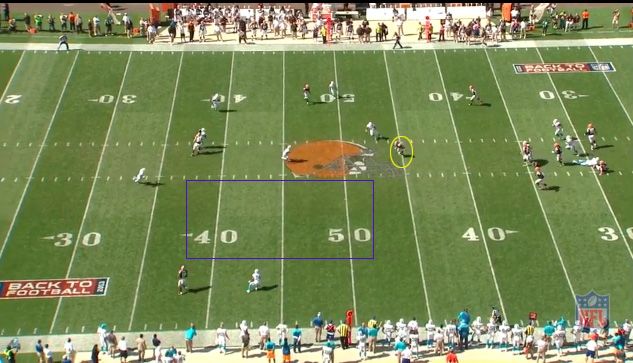

Trent tries to cut back at the 50 yard line and gets taken down at the 43 yard line as a result, unable to beat the defender with pure speed towards the sideline and not strong enough to break the wrap up tackle of the defender pursuing him. This again exposes the fact that while Richardson is very good at getting north in a hurry, he lacks the acceleration and burst necessary to transcend himself from a good, hard nosed running back into an elite upper echelon running back.
Now let us take a look at one of his runs from Week 2 against the Baltimore Ravens.
Run 3: Inside Zone on 1st & Goal for a 3 Yard Gain
On a 1st & Goal, Cleveland opts to run a zone play to the right side with Richardson cutting back to the open lane. Like the earlier mentioned run, he displays solid vision to diagnose the lane but his lack of burst hinders the potential to break through properly for a potential touchdown.
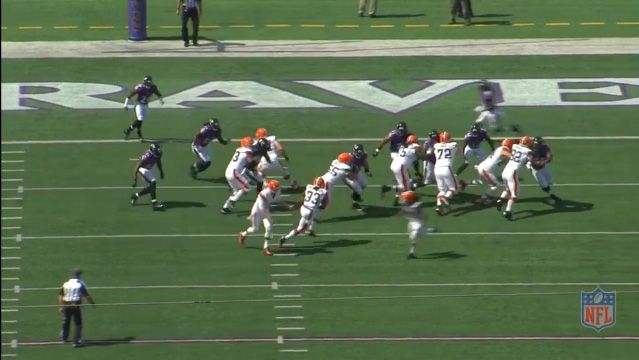
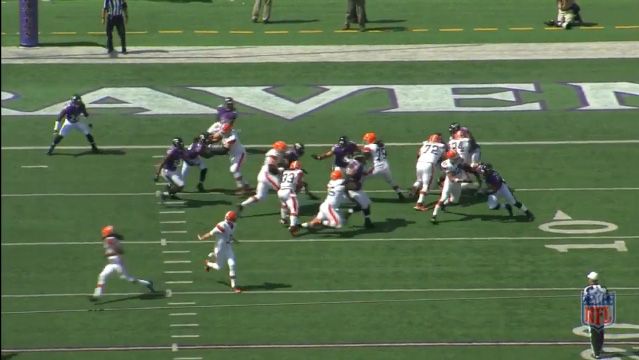

Here is one of the fatal flaws to Trent Richardson’s ability to run the ball effectively. He struggles to display flexible hips and slows down dramatically when attempting to make a sharp cut either left or right when the play demands it of him. By having to slow down or ‘gear’ down, he allows for the defense to catch up and cut off any open lanes that may have developed prior to the necessity to shift. As seen above, he has the time to hit the crease but he lacks the physical ability to match what his brain sees, ineffectively shifting his body weight to hit the hole in time resulting in a simple 3 yard gain as opposed to a possible touchdown if not getting the ball down to the 2 or 3 yard line instead.
That kind of trait, the ability to transfer weight and cut sharply, is why ‘unheralded’ Alfred Morris exploded onto the scene and dramatically helped carry Washington’s offense under Mike Shanahan’s zone blocking scheme.
Will the Trade Work For Indianapolis?
I think both teams made out very well in the deal. It was clear that Rob Chudzinski and Cleveland needed somebody with a bit more speed and burst at the running back position and Indianapolis gets a running back who can grind out tough yards on 1st & 2nd Downs as well as being a decent receiver on 3rd & Medium situtations.
Trent Richardson is not a Top 10 running back in the NFL. He simply lacks the burst and acceleration to crack that barrier. What he is, is a hard nosed bellcow running back. Those guys can succeed in the NFL as shown by BenJarvus Green-Ellis and Michael Turner, who was much faster than Richardson is. If the Indianapolis Colts are expecting a running back who can turn a 7 or 8 yard run into a run of 15 or more yards, I think they and Colts fans are going to end up disappointed in what Richardson offers them as far as that ability. In the end, what will make or break Richardson will be the big guys up front in the offensive line. If they can overpower their opponents, Richardson has a shot at challenging the 1,300 yard mark (or more with enough carries) but he needs to be a 25-30 type bellcow in order to see such numbers. Trent is not the type of running back who can split out wide or run for 140 yards on just 20 carries.
While he is a big name at the running back position, I think Cleveland did really well in being able to obtain a 1st Round pick along with possibly suiting up a talent that may provide more big play potential and fit better schematically within Cleveland’s offensive system.
Credit to NFL.com and it’s awesome NFL Game Rewind program for the videos I was able to screencapture from.
Credit to Sports Illustrated for main feature image.

